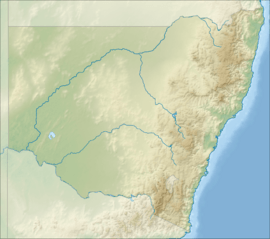Black Andrew Nature Reserve facts for kids
Quick facts for kids Black Andrew Nature ReserveNew South Wales |
|
|---|---|
|
IUCN Category Ia (Strict Nature Reserve)
|
|
| Nearest town or city | Wee Jasper |
| Established | 2001 |
| Area | 15.59 km2 (6.0 sq mi) |
| Managing authorities | NSW National Parks & Wildlife Service |
| Website | Black Andrew Nature Reserve |
| See also | Protected areas of New South Wales |
The Black Andrew Nature Reserve is a special protected area in New South Wales, Australia. It's like a big natural park where plants and animals are kept safe. This reserve covers about 1,559 hectares (that's about 3,852 acres!).
It's located on the southern side of Burrinjuck Dam. This dam is on the Murrumbidgee River. The dam is very important because it stores water for farms in the Murrumbidgee Irrigation Area.
Contents
History of the Reserve
How Black Andrew Nature Reserve Started
The Black Andrew Nature Reserve was officially created in 2001. Before it became a reserve, it was known as "Crown land." This means the land was owned by the government.
Who Manages the Reserve?
Today, the reserve is looked after by the New South Wales National Parks and Wildlife Service. They make sure the plants and animals are protected. They also follow rules set by a plan called the Southern Regional Forest Agreement.
Nature and Wildlife
Different Plant Areas (Flora)
The reserve is home to many different types of plants. Scientists have found seven main "ecosystems" here. An ecosystem is like a community where living things (plants, animals) interact with their environment (soil, rocks, water).
- Forests on Granite Rock: Some areas have soils that come from granite rock. Here, you might see tall blue gum trees and different kinds of peppermint trees. There are also silver wattle trees and ferns like Austral bracken.
- Moist Forests on Basalt Rock: Other parts of the reserve have soils from basalt rock. These areas are often more moist. You can find ribbon gum trees and more narrow-leaved peppermint. Small plants like kidneyweed and snow grass grow here too.
- Swampy Forests by Streams: Along the banks of streams, the soil is very deep. This is where you'll find apple box trees and black sallee. There are also woolly tea-trees and different types of wattle.
- Forests in Gullies: Deep gullies often have black wattle and blue gum trees. You might also spot Austral mulberry and shiny cassinia. Weeping grass and snow grass are common on the ground.
- Forests on East-Facing Slopes: On slopes that face east, you'll find apple box and Norton's box trees. Silver wattle and native geranium also grow well here.
- Rocky Escarpment Forests: The rocky, exposed areas in the northeast have tough plants. Long-leaved box trees and black cypress grow here. You might also see grass trees and different types of wattle.
- Forests on Western Slopes: The western slopes have Norton's box and red stringybark trees. Slender tea-trees and shiny cassinia are also common. Snow grass covers the ground in these areas.
Animals in the Reserve (Fauna)
The Black Andrew Nature Reserve is a busy place for animals!
- Scientists have seen three types of amphibians (like frogs).
- There are 16 different kinds of reptiles (like snakes and lizards).
- You can find 29 different types of mammals. This includes 11 kinds of bats!
- A huge variety of birds live here, with 83 different species observed.
Animals That Need Our Help (Vulnerable Species)
Some animals and plants in the reserve are considered "vulnerable." This means their numbers are getting low, and they need special protection to survive. A law called the Threatened Species Conservation Act 1995 helps protect them.
Here are some of the vulnerable species found in Black Andrew Nature Reserve:
- Australian Anchor Plant: This is a special plant that needs careful protection.
- Yellow-bellied Glider: This amazing mammal can glide through the air from tree to tree.
- Common Bent-wing Bat: A type of bat that lives in caves and needs safe places to rest.
- Powerful Owl: This is Australia's largest owl, a very important predator.
- Barking Owl: Another type of owl known for its unique barking call.
- Brown Treecreeper: A small bird that climbs tree trunks looking for insects.
- Booroolong Frog: A rare frog species that lives near streams.
These species are important parts of the reserve's natural environment. Protecting the reserve helps these special plants and animals continue to thrive.


